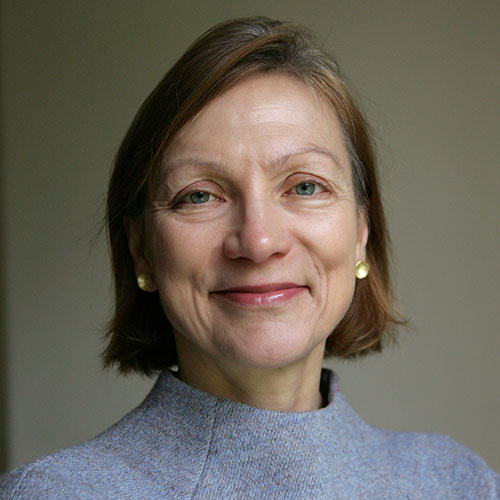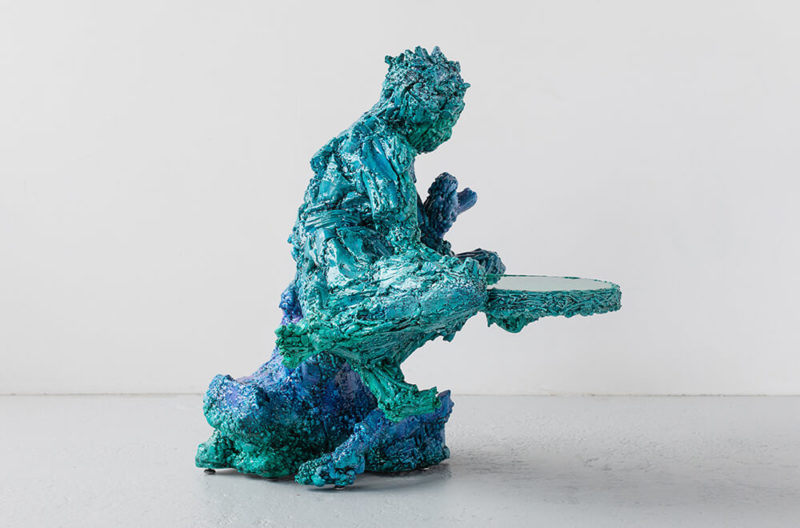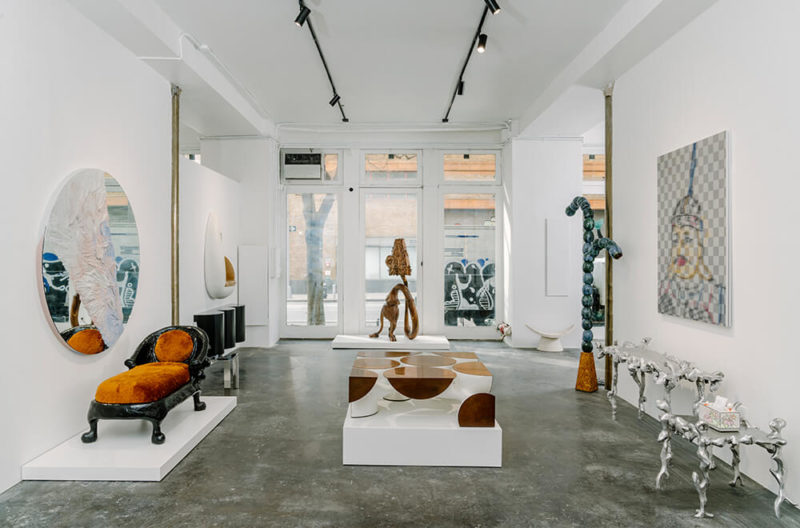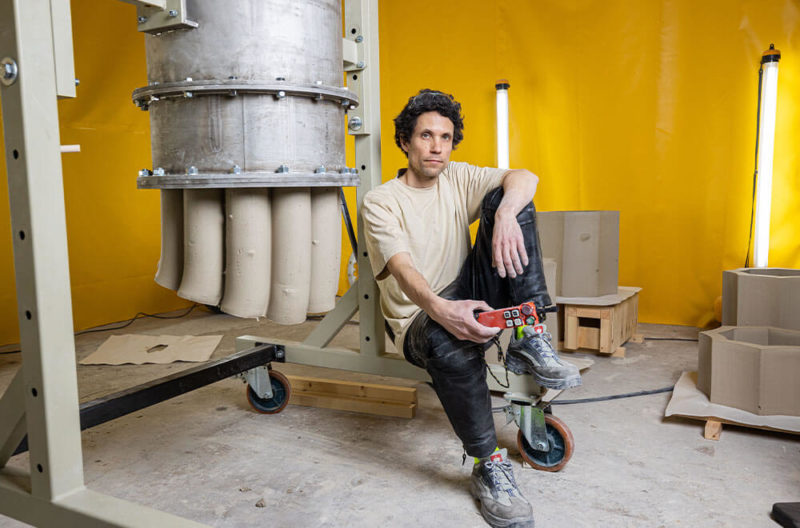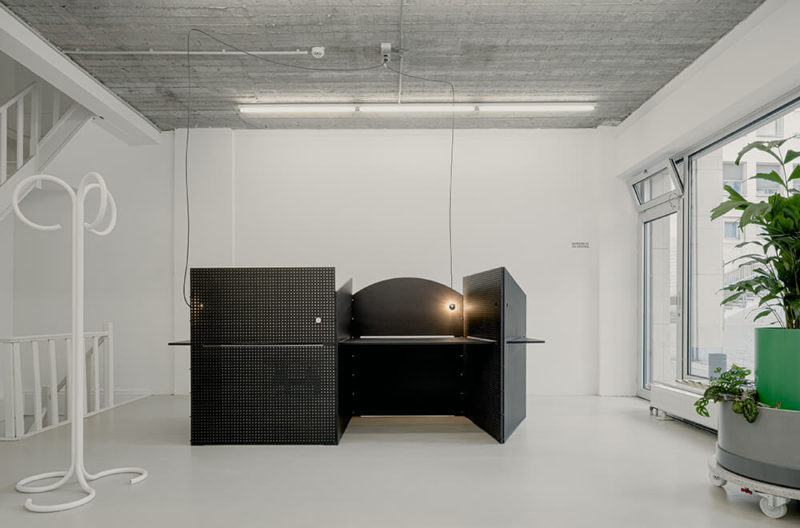Virginia Leonard
The New Zealand-based ceramicist talks to TDE about how she moved from canvas to clay, and how her work gives a voice to trauma and chronic pain.
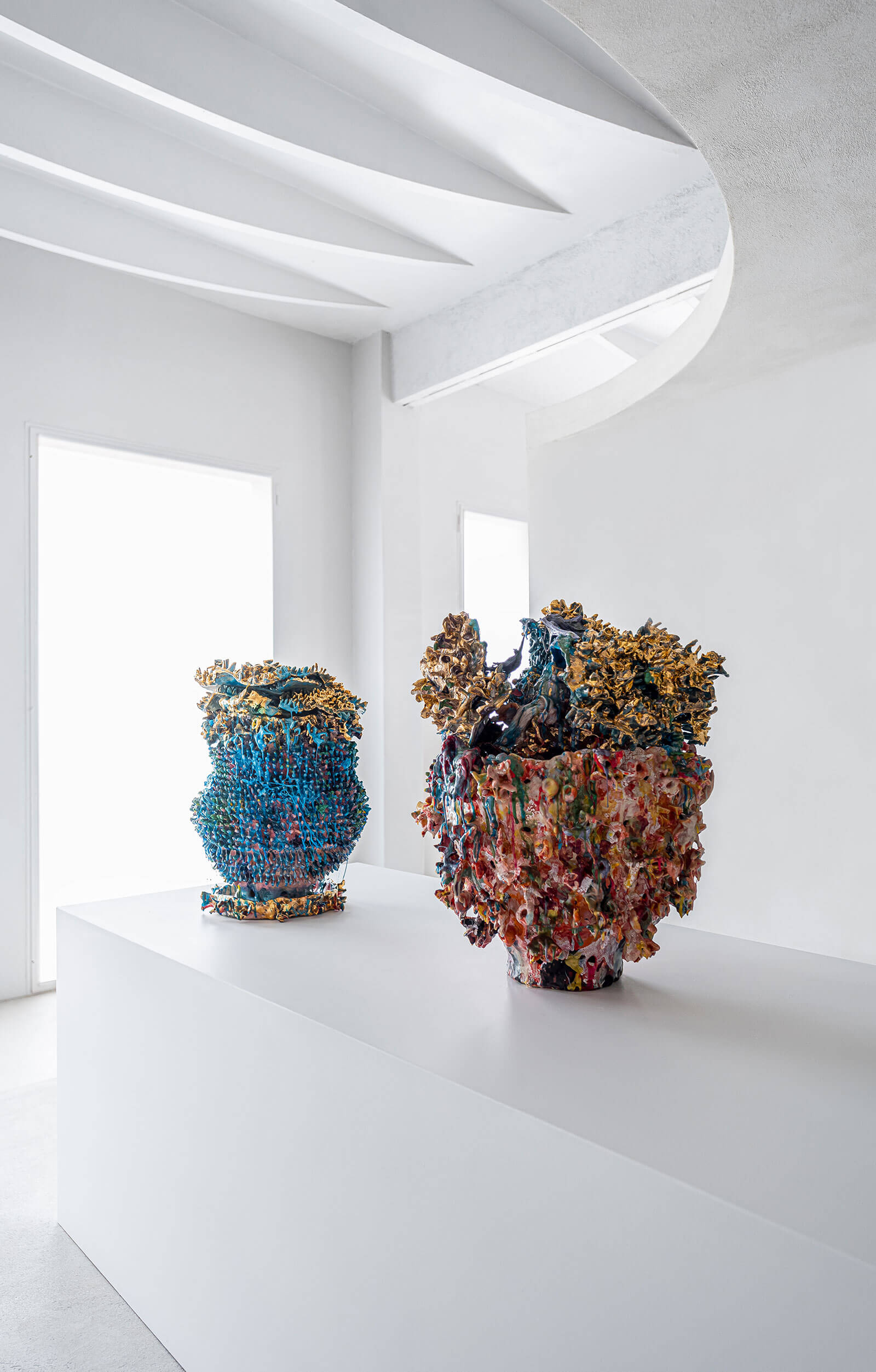
Virginia Leonard, ‘Stained Nightie’, 2022 (left); ‘A Frock Will Hide Those Sticky Out Bits He Said’, 2021 (right)
COURTESY: Virginia Leonard & Side Gallery
Emma Crichton-Miller (EC-M): Tell me how you became involved in this show?
Virginia Leonard: Side Gallery contacted me last year and said they were interested in doing a show around the premise of “Exposed Material” and an up-to-date development of ceramics as a sculptural medium from the artist’s perspective. They invited me and I said, “Sure”!
EC-M: How did you evolve this way of working? Did you start as a ceramicist, or as a sculptor? What was your relationship to the material of clay?
Virginia Leonard: I didn’t have one at all. I trained as a painter, graduating with a Master in Fine Arts in 2002. I started working in clay around 2013, but had no formal training in clay at all. That was quite uncommon then and at the time I was frowned upon for touching clay …
EC-M: What was it about clay?
Virginia Leonard: I have friends who make domestic pottery and I just picked up a piece of clay one day in one of their studios and immediately responded to the visceralness of it. In my work I’ve always been interested in gloopy, globules of thick oil paint and so I completely responded to the idea that in clay you’re much freer … you’re not restricted to putting a certain amount on a canvas before it falls off. It really excited me.
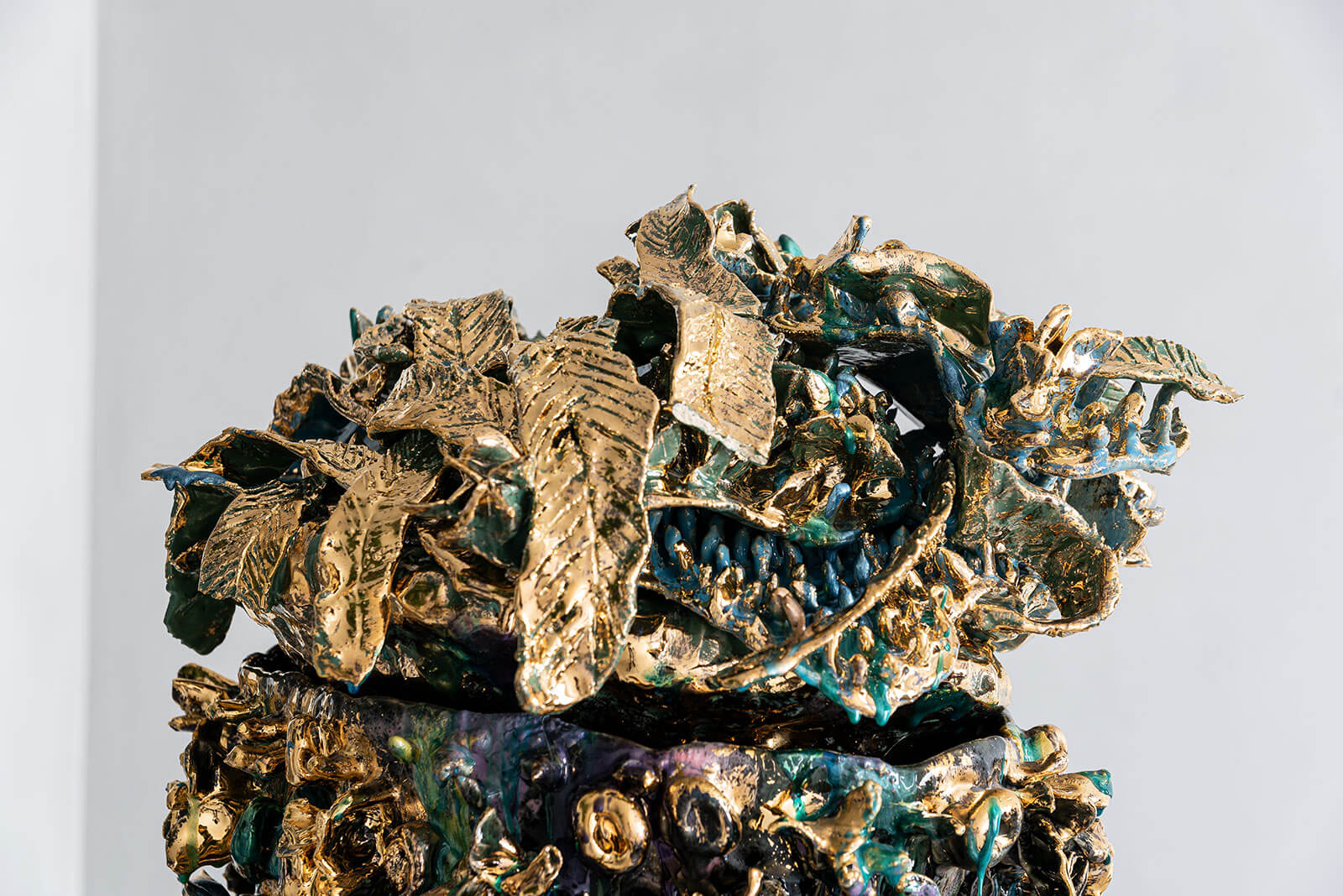
Virginia Leonard, ‘Fallen Chandelier’, 2021 (detail)
COURTESY: Virginia Leonard & Side Gallery
I started at my friend’s pottery studio up the road and after a while he said to me, “I thought you’d make an ashtray and then you’d go back to your painting studio and I’d never see you again, but six months later you’re still in my studio every day. You’ve taken over my kiln. You’ve taken over all my workbenches. This is enough! Clearly, you love this medium. Get a kiln and put it in your studio.” And I did and I haven’t picked up a paintbrush to paint a canvas again.
The other thing he said to me, which became a key bit of knowledge, was when I made a perfect round pot and he said, “This is terrible.” I went, “What! It’s perfect,” and he said, “Yes, but don’t learn anymore. You know nothing, which is why it’s great. Stop making it perfect.” That was a gem bit of information that I really took on board.
EC-M: You have more of a sculptural approach, rather than a potting approach – you’re not throwing the clay … is that right?
Virginia Leonard: Yes, I’m coiling and hand-building. Ceramics is such an old tradition of working, but because I don’t know the rules I’m not trapped. I’m quite fearless. People say I’m a risk-taker, but I don’t think it’s about that – it’s quite simply that I don’t know I’m taking risks.
EC-M: You don’t know what could go wrong?
Virginia Leonard: No idea. Let me tell you, a lot goes wrong but that’s always where the nuggets are – the beautiful gems are in the terrible mistakes.
EC-M: You seem to be drawn to the vessel – what is it about that form? Why aren’t you just doing pure sculpture?
Virginia Leonard: I’m not interested in figurative imagery at all. I really respond to abstraction. It’s definitely my comfort zone. I get stimulated by it. As soon as it becomes figurative I don’t enjoy it. I’m very much like that with painting. I don’t much like figurative painting, I like abstraction. So I keep to the vessel – even though it has that figurative form. I also like the fact that it is open. It is important to me that you can see into the guts of the work. To see the honesty and the making of it. I don’t want to hide anything.
Also, I guess in a way I’m recognising the tradition of ceramics – though I know very little about it – I still honour that vessel.
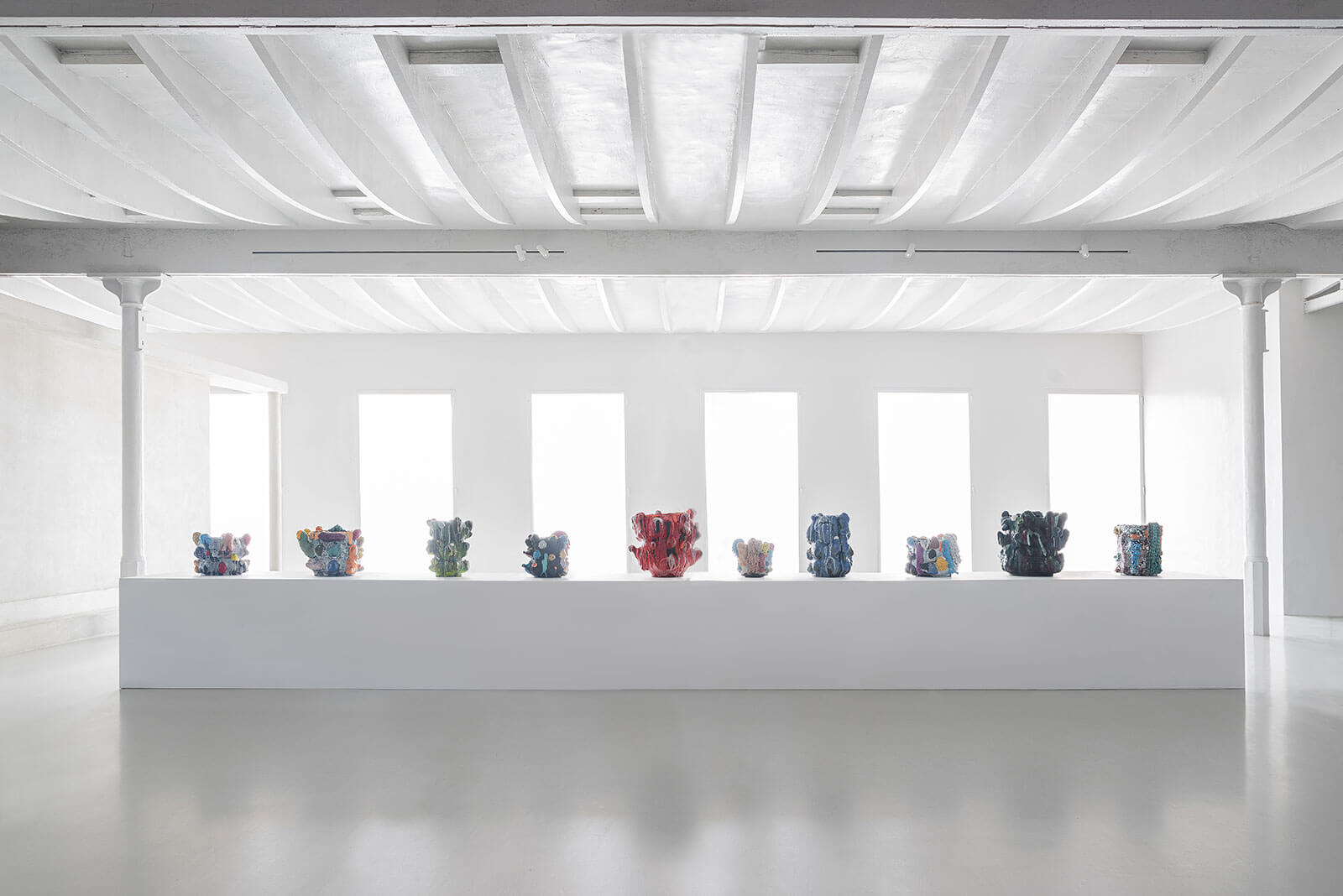
Exhibition view, ‘Exposed Material’ with Vince Palacios ceramics
COURTESY: Side Gallery
EC-M: In terms of your colours – they’re just outrageous. Sexy, frightening, seductive and beautiful. All those things. Do you use conventional glazes, which means that the colours aren’t true to what you see with your own eyes and you’re having to guess how they’ll turn out?
Virginia Leonard: I don’t measure anything – I just chuck things into my big pot of glaze and I have an idea of what I hope to achieve, but rarely do I get what I expect. It’s the lack of control which I love … But it’s so much more exciting than painting. You’re so in control with painting, but when you put that pot into a hot box, close it and turn the controller on, you have no idea of what is going to come out the next day. It is so fun. So exciting and you have to work with what you get.
EC-M: So you choose a kind of palette …
Virginia Leonard: Yes, I definitely choose my palette. And then I’ll put it back in the kiln a number of times to get the colours that I’m really after, and then I’ll usually put a lustre on it – shiny gold and platinum. I’m like a magpie, I like shiny – so there’ll always be a bit of that. I paint on the pieces at the very end, working with hot resins to apply colour. That’s the idea of formal, abstract painting. So I do control that last part.
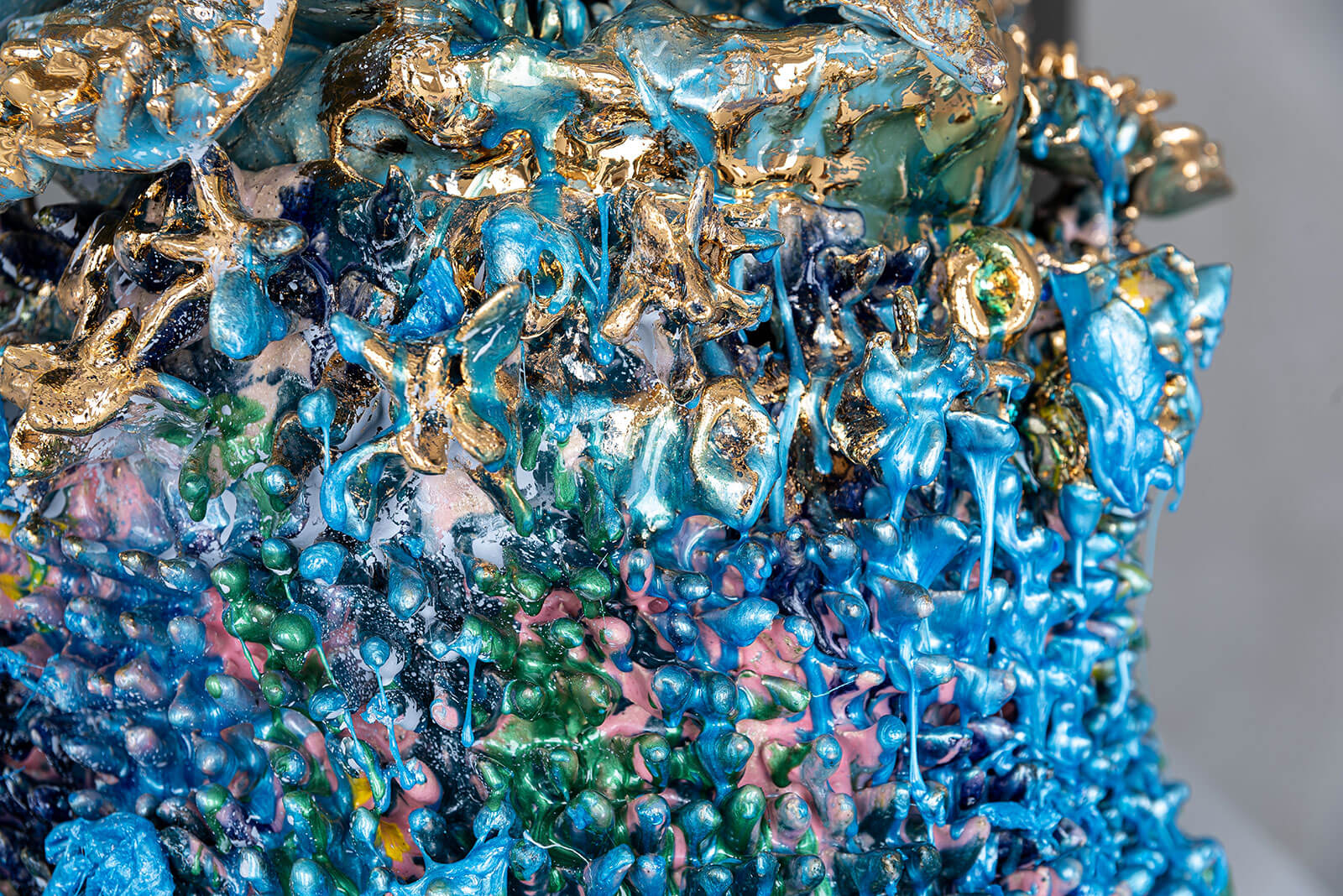
Virginia Leonard, ‘Stained Nightie’, 2022 (detail)
COURTESY: Virginia Leonard & Side Gallery
EC-M: In terms of the shapes and the forms – did these just emerge from your hands or do you draw beforehand? I’m interested as the clay is very alive in your hands as you’re building and the forms are not at all regular, they’re quite wild …
Virginia Leonard: No, I don’t draw. Drawing doesn’t help me at all actually. I think in my head all the time about it and I plan them. Then when I’m coiling I work with a soft clay so it collapses pretty easily. I work quickly so the pieces become very uneven, quite rapidly, without me even trying to make them uneven. When they’re too even they’re not as beautiful.
Or, what I do with a certain type of clay I’m working with at the moment – it’s a Californian clay – I’ll put it in the kiln and take the temperature up higher than the clay can handle, so I know that part of it will melt or collapse. I’ll prop up one side of it, but the other side will collapse, so I’m doing things like that as well.
EC-M: And that’s because you want this kind of interactive drama with the kiln in a way?
Virginia Leonard: Yes, I want to completely annihilate a certain part of the work, because the work is all about bodily scarring & trauma. I was in a bad motorcycle accident in London when I was twenty, and the work is a constant dialogue about my body – how it is on the day and the chronic pain. It’s that language that has no voice that I put into the work. So the more cracked and collapsed they are, the more I respond at an unconscious level to the work. It’s where I’m comfortable.
If you have a severe trauma on your body, you pay the price as you get older because arthritis kicks in. So this is becoming more relevant to me now, I guess, because I’m becoming much more limited physically in what I can do compared to what I could do five years ago. For me to be able to give the trauma, and the whole language of chronic pain, a voice through the work is very cathartic, because I don’t talk about it, ever. I’m in pain all the time but I don’t discuss it. I don’t talk about it with my family because there’s nothing to say, it’s pointless. But I talk about it constantly in my work.
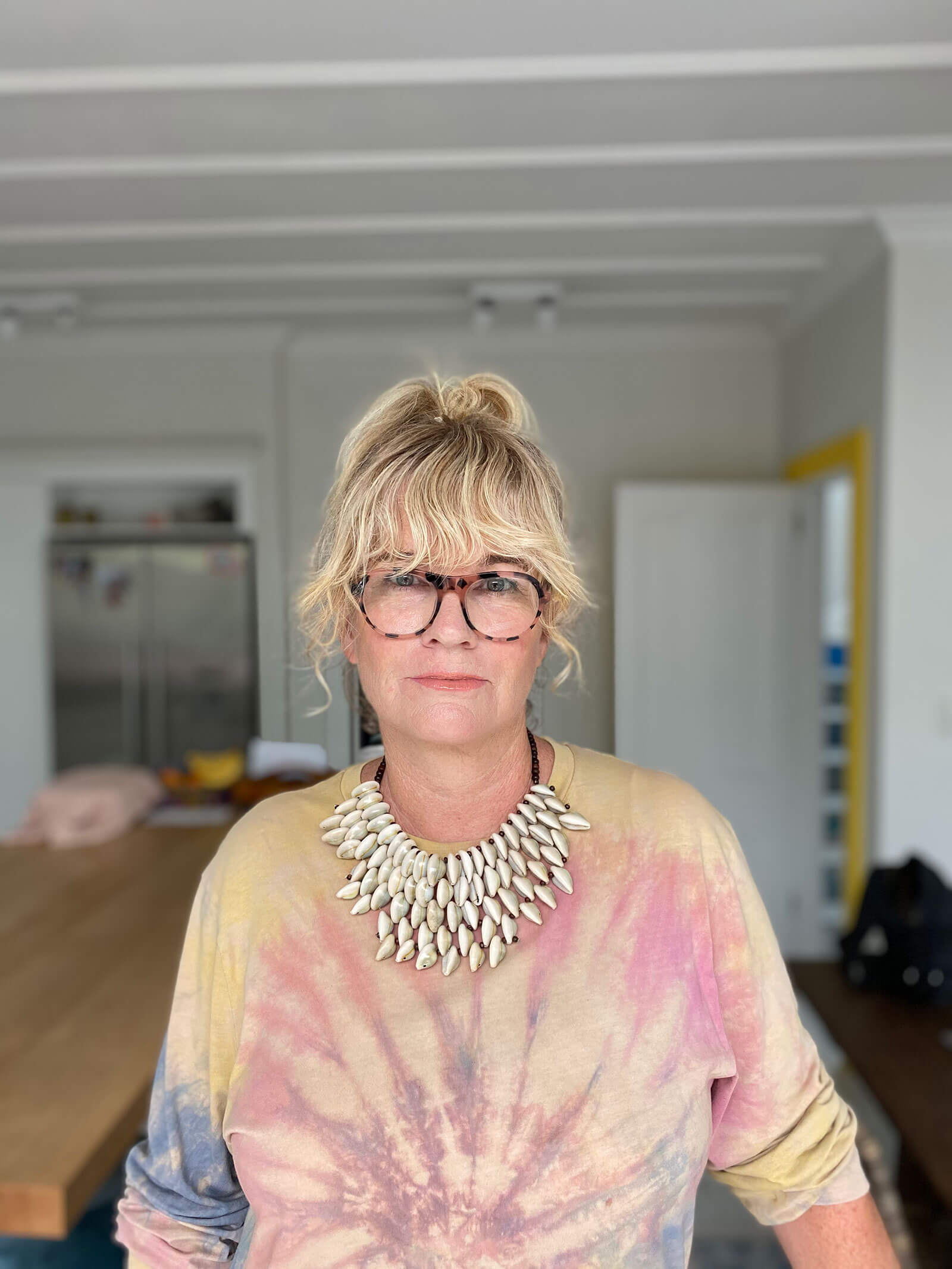
Virginia Leonard
COURTESY: Virginia Leonard & Side Gallery
EC-M: How has your work evolved?
Virginia Leonard: Well, I’ve got better at understanding how I can push that clay as hard as I can. I push it a lot further than I used to. I’m not afraid of it so much.
And the work’s got bigger … I’ve got more confident with the material and I’ve got more to say. At the beginning I was quite hesitant and I was also a bit ashamed of my body and my subject matter … it’s so personal. As a female with a disfiguration I was full of shame. And now, as I’m older, I don’t care and I carry that with a bit of pride. I think that I can feel that in the work, that I’m starting to acknowledge it and to go, “This is a journey, it’s mine and it’s fine.”
EC-M: For this show did you create a new body of work?
Virginia Leonard: One of the works is titled ‘A Fallen Chandelier’. It’s the first work I’ve done with lights and it’s the green and black work, and it’s got these protruding sort of fins coming out from the side and I’ve lit it, through lights inside those little things. There’s a movie called ‘The Hand of God’ set in Italy that came out last year. There’s this shot in it with this chandelier, it’s quite a famous artwork but I can’t find it anywhere. It’s a big, huge chandelier and it’s sitting on the ground … again it’s this idea of collapsing, of the form not being able to hold itself. It’s sitting on the ground.
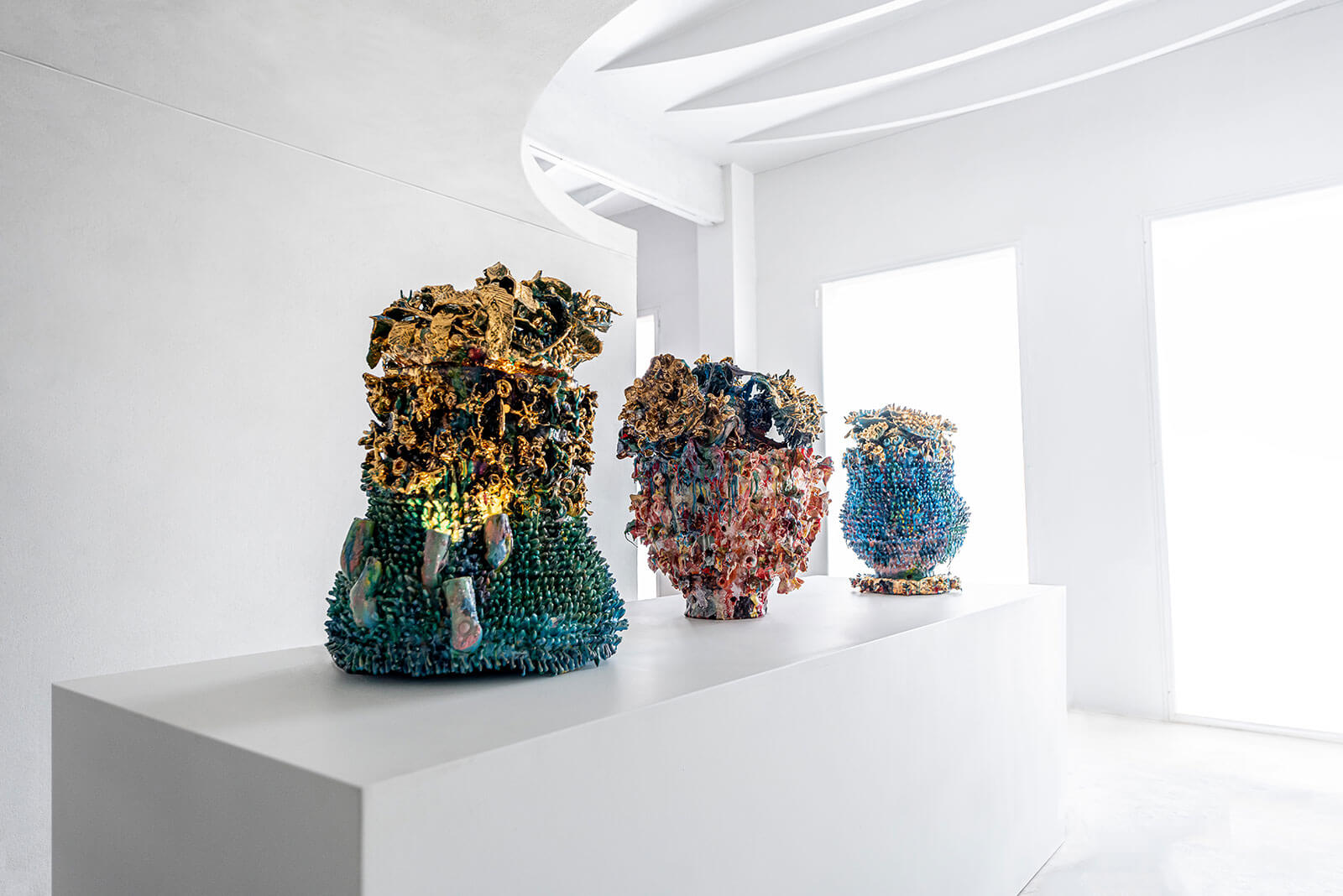
Virginia Leonard, (from left to right) ‘Fallen Chandelier’, 2021; ‘A Frock Will Hide Those Sticky Out Bits He Said’, 2021; and ‘Stained Nightie’, 2022
COURTESY: Virginia Leonard & Side Gallery
So I’ve made it and I thought it very appropriate for Europe, rather than New Zealand, as we’re such a new country we don’t have lovely, old, high buildings. So it’s a big work that can sit on the ground – my idea of a chandelier. It’s the first one I’ve made, specifically for this show, and I’m going to try and make a few.
EC-M: Are there any particular works you’d like to talk about?
Virginia Leonard: The multicoloured work, ‘A Frock Will Hide Those Sticky Out Bits He Said’, 2021 went through many iterations. It was once a single work and then I built a huge mechanical thing inside – there’s two other pots inside that work. You can peer in and you can glimpse parts of it. And then I’ve made another pot to go with it, which I’ve made, glazed and lustred. Then I’ve smashed it up with a hammer and I’ve put that work on top, and resined it all together. So it’s really heavy. It’s a big work.
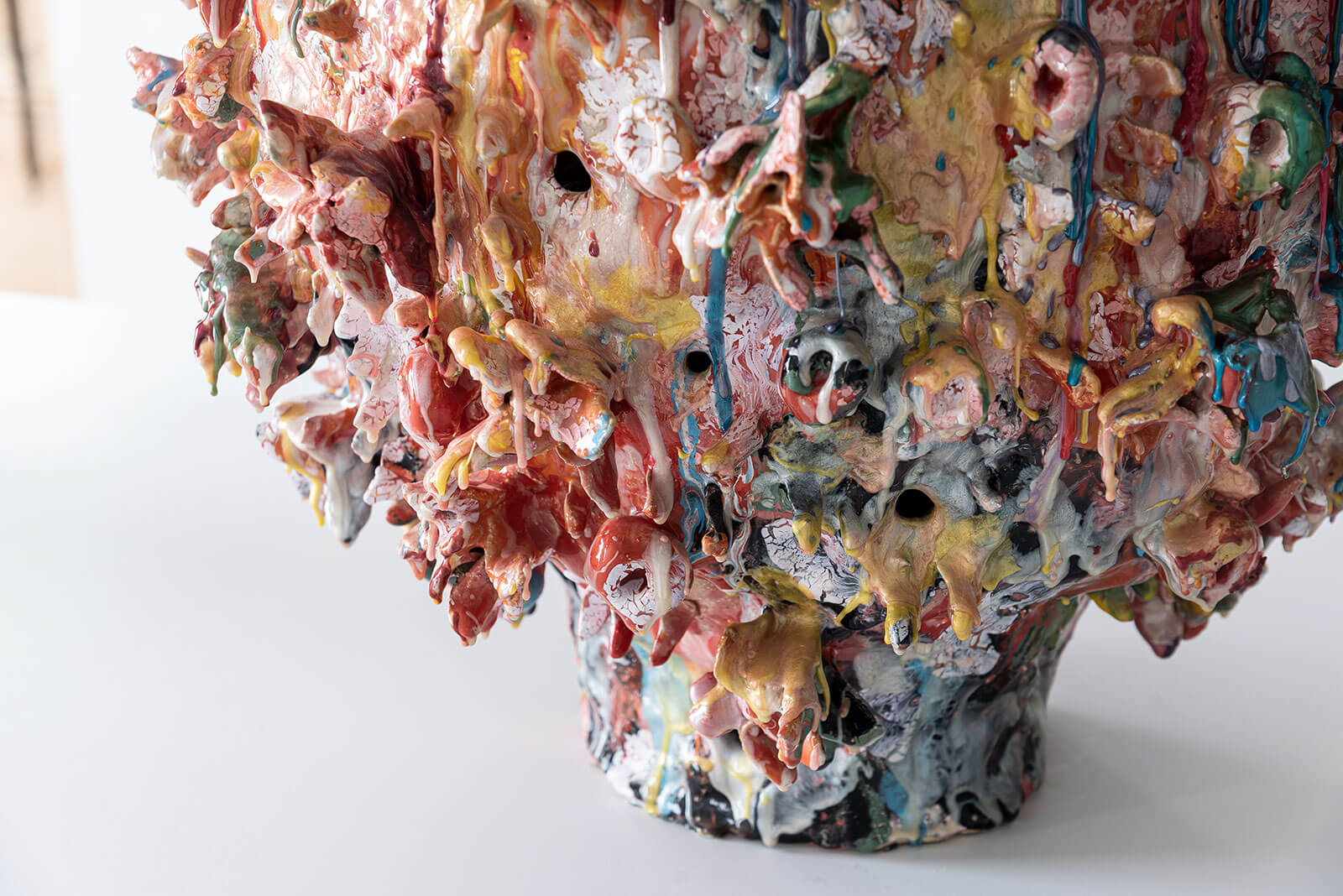
Virginia Leonard, ‘A Frock Will Hide Those Sticky Out Bits He Said’, 2021 (detail)
COURTESY: Virginia Leonard & Side Gallery
It’s the idea of that whole bodily layering … you might see me like this, but really, underneath I’m this and I’m this and I’m this. And you can see glimpses of each stage in the work. I don’t hide any of it. You can see right into the ugly parts as well. I really wanted them to have a work like that as I guess it’s the most honest I can possibly be about my work. It’s pretty, but it’s not pretty.
‘Exposed Material’ group show at Side Gallery, Barcelona, 17th March – 14th April 2022.
